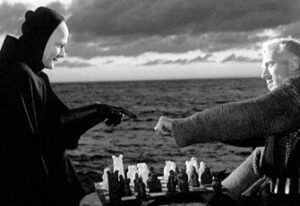Bergman’s “The Seventh Seal” – the Silence of God

Title: “The Seventh Seal” (Det sjunde inseglet)
Release Date: 1957
Director: Ingmar Bergman
Cast: Gunnar Björnstrand, Max von Sydow, Bibi Andersson, Nils Poppe, Bengt Ekerot, Inga Gill, Maud Hansson, Inga Landrige
“…and when the Lamb broke the seventh seal, there was silence in heaven for about half an hour…” – the words from the “Apocalypse of St. John” are the motto as well as the compositional clasp of the entire film by Ingmar Bergman. “The Seventh Seal” is a philosophical morality play set in medieval reality, a visually stunning image composed of cultural symbols of death, but above all it is a dramatic question about the silence of God in the face of the drama of human suffering.
“The Seventh Seal” – medieval theater mundi
Bergman has set the action of the film in medieval times. We see the knight Antonius Block, who, together with his squire Jons, returns to his homeland from the Crusade. Already the first steps of the knight on his native land are accompanied by omnipresent death. The plague, which is decimating people, is rampant in the region, and corpses can be found on every path. What is more, death itself comes to Antonius, but he wants to postpone the final moment and offers the mysterious being a game of chess. The stake is supposed to be Block’s life. Death uses all possible means to learn his opponent’s strategy and win the duel. The knight is aware that he will not escape his fate, but tormented by a sense of the meaninglessness of his life, he wants to perform an act that will give his life meaning.
The solemn theme of “The Seventh Seal” combined with medieval iconography has a truly electrifying effect. The presented world becomes a theater mundi, and the whole thing rises to the rank of a morality play, in which the forces of good and evil fight for the human soul. The suggestive whole is built on cultural clichés, such as the painterly motif of the dance macabre (procession of death), processions of mortifying penitents and pyres with burning witches juxtaposed with the carefree performances of wandering jugglers. Facing death or escaping from it in a whirl of fun and worldly pleasures – these are, as it were, eternal strategies of coping with the awareness of passing.

The sacred and the profane, the two sides of reality, are reflected in “The Seventh Seal” by numerous film manipulations. We have Per Axel Lundgren’s impressive set design, Gunnar Fischer’s contrasting black and white cinematography, and Erik Nordgren’s atmospheric music.
“The Seventh Seal” – Bergman’s own death
The central figure of all layers of the film – from the visual, to the musical, to the plot – is death in the personified form of a terrifying monk with the face of a serious jester. The phenomenal role of death is played by Bengt Ekerot. Bergman’s concept of death is clearly evocative of the tradition of German Expressionism (Fritz Lang’s ”Destiny”) and early Scandinavian cinema (Victor Sjostrom’s “The Phantom Carriage”). The character played by Begt Ekerot retains a mysterious ambiguity – on the one hand his attribute is dignity, on the other cunning and maliciousness.
The most intriguing thing about death in “The Seventh Seal” is the play between its consciousness and the unconscious nature of things. It is not entirely clear whether death knows the answers to the questions tormenting the protagonist: is there a God, and does human life have any hidden meaning? She presents herself as a helpless tool of fate – an unaware executor of eternal laws. But can one trust such a cunning player?

“The Seventh Seal” – the world after the opening of the seventh seal
Bergman’s “The Seventh Seal” is certainly an allegorical work. For the medieval theater mundi is an image of the modern world, plagued by every possible evil. It is, in a way, the reality of the fulfilled apocalypse (we must remember the context of World War II, which is fresh in relation to the time when the film was made). We live in a world after the opening of the seventh seal – the great Swedish director seems to be saying. The most striking feature of this state is God’s complete silence in the face of the evil happening around us. Modern man is guided not so much by faith as by a deep desire for it, personified by the noble knight Block, who is searching for the truth. At the same time, however, the human being, like Squire Jons, is full of cynicism and doubt in any purposefulness and metaphysical core of reality. Block and his servant are therefore, in a way, one character reflecting human duality.
In a meaningless world, death seems to be the only certainty – it visits everyone without exception, regardless of philosophical dilemmas or human desires. Bergman’s vision is not entirely pessimistic, however. There is hope, and that hope is in staying true to simple values such as love. While Block joins the procession of death with his wife and travelling companions, a young couple of itinerant actors get a chance for a happy life: Jof and Mia with their one-year-old son.
The rescue of these two characters has a symbolic meaning in the context of Bergman’s profession. Art, understood as giving joy to others, becomes a significant vocation. The sense of existence is hidden in the simplest things – the joy of having loved ones, a spring sunset, and the taste of forest strawberries (the eternal hallmark of the Swedish master’s cinema).
Literature:
„Kino klasyczne”, pod red. T. Lubelskiego, I. Sowińskiej i R. Syski, Kraków 2012.
